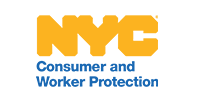
 Consumer and Worker Protection311
Consumer and Worker Protection311 Search all NYC.gov websites
Search all NYC.gov websites
Self-Employed Filers
Tax Prep for Self-Employed Filers: Toolkit
Who is this toolkit for?
This toolkit is for self-employed New Yorkers. If you are self-employed, this toolkit will help you understand how self-employment taxes work and give you some tips on how to best prepare yourself for tax season.
Click a topic, or press the enter key on a topic, to reveal its answer.
Is this toolkit for me?
Although many people work for themselves, or are in business for themselves, they may describe their employment status in different ways. Some of the most common technical terms to describe self-employment are:
- Sole proprietors
- Freelancers
- Gig workers
- Independent contractors
- Small businesses owners
This toolkit is for people who file taxes as self-employed individuals. Some examples of people who are treated as self-employed are:
- Independent drivers using taxis or apps, such as Uber and Lyft
- Delivery workers using apps, such as Delivery.com, DoorDash, Grubhub, Postmates, Uber Eats, etc.
- Certain childcare providers, such as home-based daycares and childcare cooperatives
- Freelancers, such as artists, writers, graphic designers, and musicians
- By-the-job professionals doing project-based work
Some companies may classify workers as independent contractors when they are, in fact, employees. This is called “misclassification.” Report suspected misclassification to the Internal Revenue Service and the New York Department of Labor.
If you are self-employed, this toolkit will help you understand how self-employment taxes work and give you some tips on how to best prepare yourself for tax season.
Tips to Help You Be Successful
- Keep good books. If you use bookkeeping software, check it for accuracy. If you use your own income and expenses tracker, make sure it is updated regularly.
- Save all of your receipts, ledgers, invoices, and proofs of payment. These can be saved directly in a folder on your computer, in an app or software, or as physical copies. It’s good practice to keep your receipts for at least three years from the date you file taxes.
- Collect the supporting documents you need to file your taxes. Visit the file organizer tool to keep track of all your materials.
- Plan how you will submit your annual tax returns and pay your Federal and State estimated quarterly taxes. You can file your return online using an IRS-approved free or low-cost e-file service, or file in person with an NYC Free Tax Prep provider. You can pay estimated quarterly taxes online or by mail.
- Review the Self-Employed Tax Prep Info Sheet for more information about the tax filing process for self-employed individuals from start to finish.
This page was updated 10/2023.


